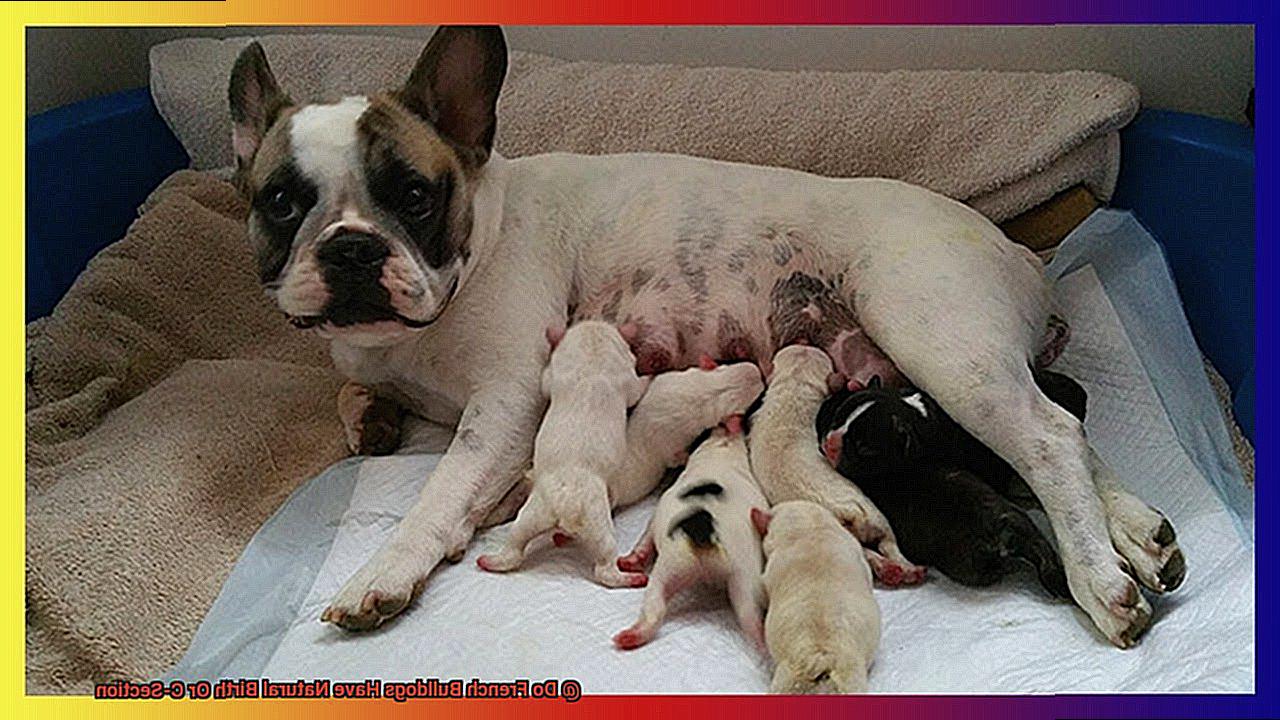Do French Bulldogs Have Natural Birth Or C-Section?
Welcome to our blog post where we dive into the intriguing world of French Bulldog childbirth. Are you a proud Frenchie owner or just curious about how these adorable pups make their grand entrance into the world? Well, you’ve come to the right place.
When it comes to giving birth, French Bulldogs are a bit different from other dog breeds. Their unique physique makes natural birth a risky and challenging process for both mom and her precious puppies. That’s why many breeders and vets opt for a C-section instead.
A C-section, short for Caesarean section, is a surgical procedure where the puppies are delivered through an incision in the mom’s belly and uterus. It ensures a controlled and safe delivery, minimizing any potential risks or complications that may arise during natural birth.
One perk of a C-section is that breeders can plan and schedule the delivery with precision. This allows them to better manage any potential complications that might pop up during labor. Plus, if necessary, they can perform a C-section regardless of any issues that arise during the birthing process.
But there are downsides too. C-sections are invasive surgeries that come with risks for the mom, such as infections, anesthesia complications, and longer recovery time. Puppies born via C-section may also need extra help with breathing and require additional medical attention during their early stages of development.
While C-sections are common among French Bulldogs, it’s important to note that not every delivery requires surgical intervention. Natural birth can still happen successfully in some cases—especially when the dog is healthy, has had successful natural births before, and is under the watchful eye of experienced breeders and vets.
The Anatomy of a French Bulldog: Why Natural Birth is Difficult
Contents
- 1 The Anatomy of a French Bulldog: Why Natural Birth is Difficult
- 2 What is a C-Section?
- 3 Factors to Consider When Deciding on a C-Section
- 4 Timing is Crucial for French Bulldog C-Sections
- 5 The Procedure for a French Bulldog C-Section
- 6 Post-C-Section Care for Mother and Puppies
- 7 Risks of C-Sections for French Bulldogs
- 8 Choosing a Reputable Breeder to Minimize the Need for C-Sections
- 9 Conclusion
Today, we’re diving deep into the fascinating world of French Bulldog anatomy and exploring why natural birth can be as challenging as driving a bulldozer through a narrow alleyway. So grab a cup of coffee, put on your bulldog lover hat, and let’s get started.
Flat-Faced Woes: The Brachycephalic Bulldozer
One of the primary reasons why natural birth is difficult for French Bulldogs is their unique brachycephalic, or flat-faced, structure. Imagine trying to push a watermelon out of a narrow tube – that’s the struggle these adorable pooches face during labor. Their wider and flatter heads make it harder for the puppies to pass through the birth canal smoothly. It’s like trying to fit a square peg into a round hole.
Narrow Birth Canal: The Alleyway Jam
To add to the bulldozer challenge, French Bulldogs have a narrower birth canal compared to other breeds. It’s like trying to squeeze a bulldozer through an alleyway – not an easy task. This narrow passage makes it even more difficult for the little bulldog puppies to make their grand entrance into the world.
Big Heads and Shoulders: A Tight Squeeze
French Bulldogs are known for their larger heads and shoulders compared to their compact bodies. It’s like trying to wear skinny jeans after indulging in one too many treats – tight and uncomfortable. This disproportionate body structure can further complicate the birthing process, making it extra challenging for these adorable pups.
Short Legs and Compact Bodies: Tricky Positions
Have you ever tried doing yoga with short legs? Well, that’s what French Bulldogs experience when it comes to assuming the necessary positions for natural birth. Their short legs and compact bodies make it more challenging for them to get into the right birthing positions. It’s like trying to touch your toes without bending your knees – not the easiest task.
The Eyes Have It: Watch Out.
French Bulldogs have those big, round, and oh-so-adorable eyes. But during birth, these precious peepers can be a cause for concern. The pressure exerted during contractions can potentially cause eye injuries or complications. It’s like trying to juggle flaming torches – one wrong move, and things can go up in smoke.
Health Hurdles: The Bulldozer Obstacles
French Bulldogs are prone to certain health issues that can make natural birth even more challenging. Conditions like narrow nostrils, elongated soft palates, and tracheal stenosis can impede their ability to breathe properly during labor. It’s like trying to run a marathon with a brick tied to your leg – not an easy feat.
What is a C-Section?
That’s where C-sections come in. In this blog post, we’ll dive into what a C-section is, why it’s common for French Bulldogs, and what to expect if your Frenchie needs one.
What is a C-Section?
A C-section, short for Cesarean section, is a surgical procedure performed to safely deliver puppies through incisions made in the mother’s abdomen and uterus. It’s like a special delivery for our furry friends.
Why Do French Bulldogs Often Need C-Sections?
- Brachycephalic Features: French Bulldogs have a unique brachycephalic (short-nosed) structure that can make natural birth difficult. Imagine trying to push a watermelon through a narrow tube – not an easy task.
- Narrow Birth Canal: These lovable bulldogs also have a narrow birth canal, making it challenging for them to squeeze those adorable puppies out. It’s like trying to squeeze a bulldozer through an alleyway – not gonna happen.
- Large Heads and Shoulders: On top of that, French Bulldogs have larger heads and shoulders compared to their bodies. This makes the birth canal even tighter, like trying to fit into your favorite pair of jeans after eating one too many croissants.
- Short Legs and Compact Bodies: Lastly, their short legs and compact bodies make it difficult for them to assume the necessary positions for birth. It’s like trying to touch your toes without bending your knees – nearly impossible.
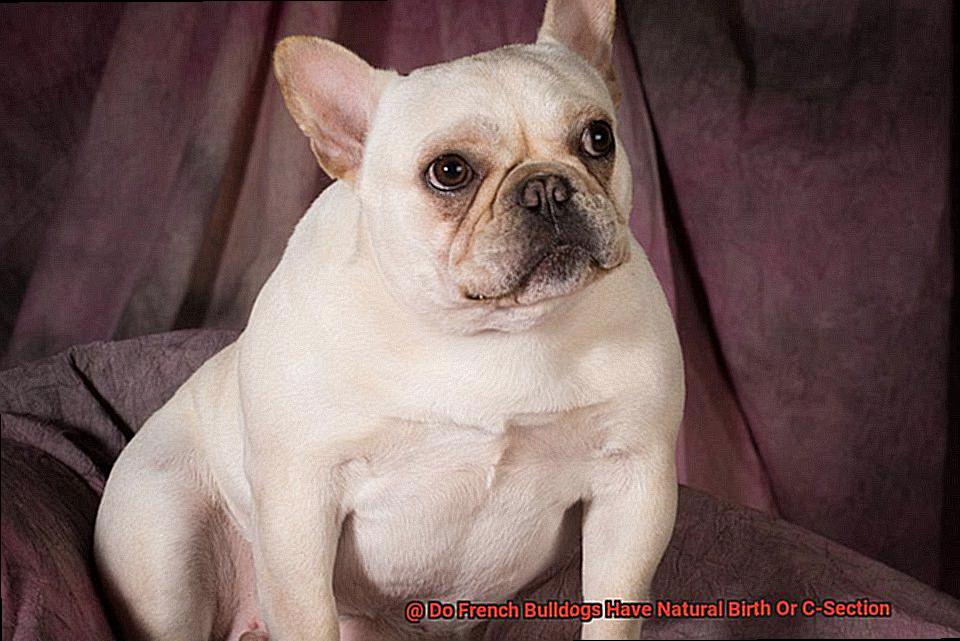
When is a C-Section Necessary?
A C-section for French Bulldogs may be necessary if:
- Labor isn’t progressing
- The mother is in distress
- The puppies are not in the correct position
- The puppies are too large for a safe vaginal delivery
The C-Section Process:
Incisions: The surgeon makes incisions in the lower abdomen and uterus to access the puppies.
- Delivery: The puppies are carefully lifted out of the uterus, and the umbilical cord is clamped and cut. It’s like a puppy rescue mission.
- Closure: Once all the puppies are delivered, the incisions are closed with stitches or staples, just like when you sew up your favorite pair of jeans.
Factors to Consider When Deciding on a C-Section
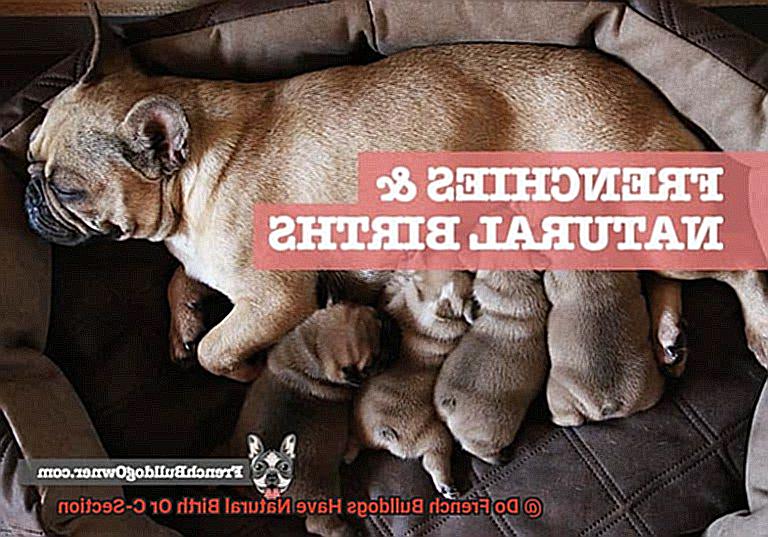
Giving birth can be a challenging and risky process, especially for French Bulldogs. The unique characteristics of this breed make natural birth a difficult option. In this blog post, we will explore the factors that should be considered when deciding on a C-section for French Bulldogs, helping you make an informed decision for the well-being of your furry friend.
- Size and shape of the mother’s pelvis: French Bulldogs have a broad, short skull and a compact body, which can make it difficult for them to deliver puppies naturally. The narrow birth canal may not allow for the safe passage of puppies during birth.
- Size of the puppies: French Bulldogs tend to have large heads in proportion to their bodies. This can increase the risk of dystocia, where the puppies’ heads are too big to pass through the birth canal without complications or obstruction. A C-section ensures a safer delivery for both the mother and her puppies.
- Breed predisposition to health conditions: French Bulldogs are prone to respiratory problems due to their brachycephalic features. During labor, they can easily become exhausted, which can lead to complications and endanger the well-being of both the mother and her puppies. A C-section helps reduce these risks.
- Veterinarian expertise: Not all veterinarians are experienced in delivering French Bulldog puppies or performing C-sections. It is crucial to find a veterinarian who specializes in reproductive health and has knowledge of brachycephalic breeds. Their expertise will ensure a successful procedure and post-operative care.
- Timing of the C-section: It is generally recommended to perform a C-section before the mother goes into active labor. This helps minimize risks and ensures a smoother delivery process. Regular check-ups with your veterinarian and close monitoring of the pregnancy will help determine the right timing for the procedure.
By considering these factors, breeders and owners of French Bulldogs can make an informed decision about the method of delivery. Consulting with a veterinarian who specializes in reproductive health and has experience with the breed is essential for guidance and support.
Timing is Crucial for French Bulldog C-Sections
Timing is Crucial for French Bulldog C-Sections
French Bulldogs are known for their adorable squishy faces and compact bodies, but their unique anatomy can pose challenges when it comes to giving birth. Due to their brachycephalic (short and compressed skull structure) nature, French Bulldogs often require C-sections to safely deliver their puppies. In this blog post, we’ll explore why timing is crucial for French Bulldog C-sections and how it can ensure the best outcome for both the mother and her precious pups.
Why are C-sections necessary for French Bulldogs?
Natural birth can be risky for both the mother and the puppies due to the brachycephalic features of French Bulldogs. The narrow birth canal can make it difficult for puppies to pass through, increasing the risk of complications such as respiratory distress and injury. C-sections provide a safe alternative, allowing the veterinarian to carefully deliver each puppy without putting their health at risk.
The optimal timing for a French Bulldog C-section
Timing is everything when it comes to French Bulldog C-sections. The ideal time for the surgery is usually around day 60 of pregnancy. This allows the puppies to fully develop in the womb and reduces the risk of complications during surgery. Veterinarians closely monitor the mother’s progesterone levels and perform ultrasounds to determine the best timing for the C-section. They also consider factors such as the size of the litter and the overall health of the mother.
Performing a C-section too early or too late can have negative consequences. If done too early, puppies may be underdeveloped and require intensive care. On the other hand, waiting too long increases the risk of complications during delivery.
The process of a French Bulldog C-section
Once the timing for the C-section is determined, preparations for surgery begin. The mother will be fasted beforehand to prevent any complications during anesthesia. Anesthesia will be administered, and the surgical site will be prepared.
During the C-section, an incision is made in the mother’s abdomen and uterus to remove the puppies one by one. The veterinarian will carefully deliver each puppy, ensuring that they are breathing and healthy before moving on to the next one. After all the puppies are safely delivered, they will be checked for any abnormalities or health issues.
Post-operative care for both the mother and puppies is crucial. Owners must follow the veterinarian’s instructions, including administering medications, keeping the incision clean, and monitoring for any signs of distress.
The Procedure for a French Bulldog C-Section
Today, let’s dive into the fascinating world of French Bulldog C-sections. We all know these squish-faced cuties are prone to some birthing complications, but fear not. With the right timing and expert care, we can ensure a safe delivery for both momma dog and her adorable little bundles of joy.
Timing is Key:
You might be wondering, “Why is timing so crucial?” Well, my friend, it’s all about finding that sweet spot around day 60 of pregnancy. You see, French Bulldogs have narrow birth canals and compressed skulls, making natural birth a risky business. So, we want to make sure the puppies are fully developed but not overstaying their welcome.
To nail that perfect timing, veterinarians keep a close eye on progesterone levels and perform ultrasounds. These tools help them pinpoint the ideal moment for surgery. It’s like conducting a symphony of life.
Let the Surgery Begin:
Once the timing is locked in, it’s go time. The mother dog is prepped for surgery, and anesthesia kicks in to ensure her comfort and pain-free experience. The veterinarian then makes an incision in her abdomen, carefully accessing the womb.
One by one, the veterinarian gently removes each puppy from their cozy haven. But this isn’t a solo act. A trusty veterinary assistant stands by to help clean the puppies and check their health. It’s like a well-choreographed dance between professionals.
Closing Time:
After all the pups have made their grand entrance, it’s time to close up shop. The veterinarian sutures the mother’s uterus closed to ensure proper healing. Then, they suture the incision in her abdomen with precision and care.
Recovery and Care:
Post-operative care is crucial for both momma dog and her precious pups. Pain medication may be prescribed to manage any discomfort the mother may experience after surgery. She will be closely monitored during her recovery, ensuring she wakes up from anesthesia properly and without complications.
And let’s not forget about the little ones. A quiet and comfortable environment is essential for their recovery. They will need warmth, cleanliness, and regular monitoring to thrive in those early days.
Post-C-Section Care for Mother and Puppies
Congratulations on the arrival of your French Bulldog puppies. After a C-section delivery, it’s important to provide proper care for both the mother and her little ones. In this post, we’ll guide you through the post-operative care that the mother needs, as well as the steps to ensure the well-being of the puppies.
Monitoring the Mother:
- Keep a close eye on the incision site for any signs of infection or complications.
- The veterinarian may prescribe pain medication to manage any discomfort she may be experiencing.
Providing a Comfortable Space:
- Give the mother a quiet and comfortable area where she can rest and recover.
- Ensure clean bedding and keep the area warm and draft-free to help her relax and focus on caring for her puppies.
Managing Appetite:
- The mother may have a decreased appetite after surgery, so monitor her food and water intake closely.
- Offer small, frequent meals that are easily digestible to stimulate her appetite.
- Fresh water should be provided at all times to prevent dehydration and promote lactation.
Wound Care:
- Keep the incision site clean and dry, following any instructions provided by the veterinarian.
- Prevent excessive licking or scratching of the incision site to minimize the risk of infection.
Creating a Stress-Free Environment:
- Provide a calm and stress-free environment during the mother’s recovery period.
- Limit visitors and loud noises to reduce stress levels, allowing her to focus on caring for her puppies.
Veterinary Check-Ups:
- Regular veterinary check-ups are necessary to monitor the mother’s healing progress.
- The veterinarian will assess the incision site, check for signs of infection, and ensure a smooth recovery.
Puppies’ Well-Being:
- The puppies should have regular access to their mother for nursing, as her milk provides essential nutrients and antibodies.
- Proper socialization is crucial for their early development. Expose them to different sights, sounds, and gentle handling.
Transition to Solid Food:
- Gradually wean the puppies from their mother’s milk and introduce them to solid food under the guidance of a veterinarian.
- This transition should be done gradually to avoid digestive upset.
Monitoring Growth and Development:
- Regular veterinary check-ups will help monitor the puppies’ growth and ensure they are reaching milestones appropriately.
- Early identification of any potential health issues is crucial for their well-being.
Risks of C-Sections for French Bulldogs
However, in some cases, a C-section may be necessary to ensure the safe delivery of the puppies. While C-sections can be life-saving, it’s essential to understand the potential risks and complications associated with this procedure.
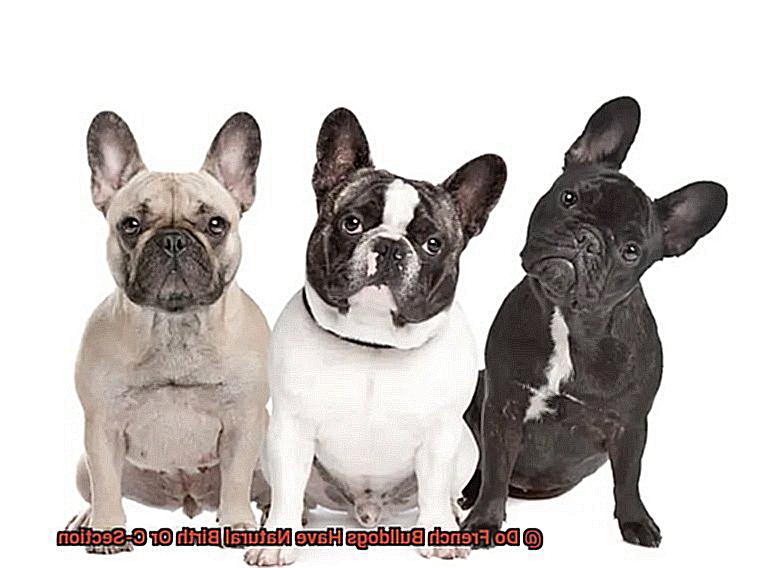
Infection:
Just like with any surgical procedure, there is a risk of infection following a C-section. French Bulldogs are particularly susceptible to infections due to their unique anatomy and brachycephalic (short-nosed) features. To minimize this risk, veterinarians typically administer antibiotics before and after the surgery.
French Bulldogs have a higher sensitivity to anesthesia compared to other breeds, making them more prone to complications during surgery. It is vital for veterinarians to closely monitor your dog’s vital signs throughout the procedure to ensure their safety.
Hemorrhage:
During a C-section, there is a risk of damaging blood vessels, leading to excessive bleeding. Veterinarians must be prepared to address any hemorrhaging promptly to prevent complications.
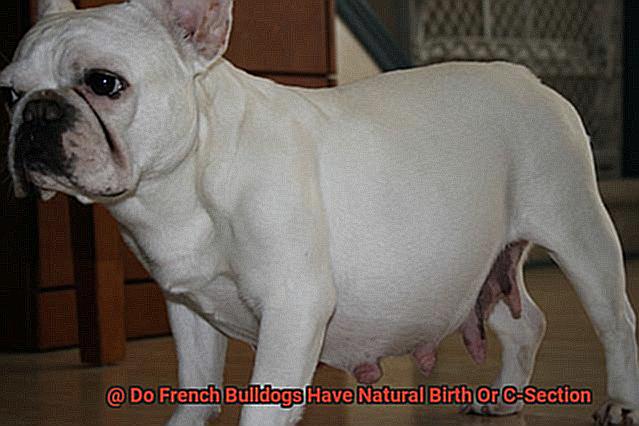
Injury to internal organs:
In some cases, previous surgeries or underlying conditions can result in adhesions or scarring, increasing the risk of injury to the mother’s internal organs during a C-section. Skilled and experienced surgeons are crucial in minimizing these risks.
Postoperative complications:
Wound infections and dehiscence (separation of the surgical incision) can occur after a C-section. Proper wound care, including keeping the incision clean and dry, is essential in preventing these complications.
Challenging recovery:
Recovering from a C-section can be more challenging for French Bulldogs compared to natural birth. The mother may experience pain and discomfort, and it may take longer for her to regain her strength and energy. Adequate pain management and postoperative care are crucial during this period.
Puppies’ health and development:
The stress of the surgery and the separation from their mother can impact the health and development of the puppies born via C-section. Close monitoring and proper care are necessary to ensure their well-being.
Choosing a Reputable Breeder to Minimize the Need for C-Sections
Bringing a new furry friend into your family is an exciting time, but it’s essential to choose a reputable breeder who prioritizes the health and well-being of their dogs. When it comes to French Bulldogs, a breed known for potential complications during birth, finding a breeder who takes steps to minimize the need for C-sections is crucial.
In this article, we will explore the key steps a breeder should take to reduce the risk of C-sections and ensure a smooth delivery for both the mother and her puppies.
Thorough Research:
Start by doing your homework and finding breeders with a good reputation. Look for those who prioritize health and have a track record of producing healthy puppies. Seek referrals from other French Bulldog owners or previous buyers, as their experiences can provide valuable insights into the breeder’s practices.
Health Screening:
A reputable breeder will carefully select breeding pairs based on their health and genetic history. They will conduct health screenings on both the male and female dogs to identify any potential issues that could impact pregnancy and delivery. This includes tests for conditions such as hip dysplasia, patellar luxation, and brachycephalic syndrome.
History of Successful Natural Births:
Choose breeders who have a history of successful natural births in their breeding pairs. This indicates that the female has a well-functioning reproductive system and is capable of giving birth without intervention.
Regular Monitoring during Pregnancy:
Reputable breeders will closely monitor the pregnant female’s health throughout her pregnancy. Regular veterinary check-ups and ultrasounds can help identify any potential problems early on, allowing for timely intervention if needed.
Proper Nutrition and Care:
Providing proper nutrition and care during pregnancy is vital for the health of both the mother and her puppies. A well-balanced diet, regular exercise, and appropriate supplements can contribute to a smoother pregnancy and delivery.
Emergency Preparedness:
While every effort should be made to avoid C-sections, emergencies can arise. Reputable breeders will have a plan in place for such situations. They will have access to experienced veterinarians who are familiar with French Bulldog deliveries and can perform C-sections if necessary.
Conclusion
In conclusion, French Bulldogs typically require a C-section for giving birth due to their unique physical characteristics.
The breed’s large heads and narrow pelvises make natural birth difficult and potentially dangerous for both the mother and puppies. Therefore, responsible breeders opt for C-sections to ensure the safety and well-being of the mother and her offspring.
This surgical procedure allows for a controlled delivery, minimizing any potential risks or complications that may arise during childbirth.
